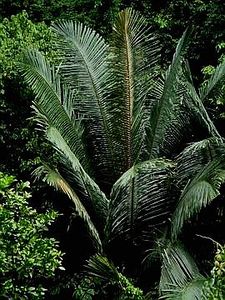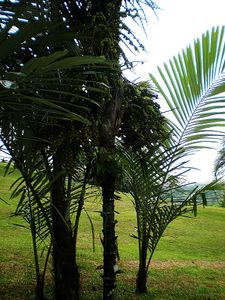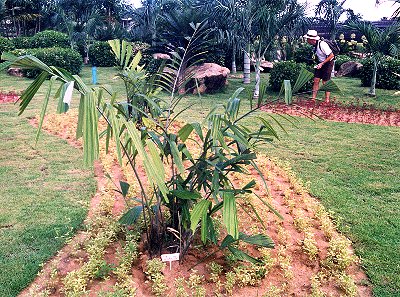Arenga obtusifolia
<google>CH02</google>
| Arenga obtusifolia | |||||||
|---|---|---|---|---|---|---|---|
 Seedlings, Hawaii | |||||||
| Scientific Classification | |||||||
| |||||||
| Synonyms | |||||||
|
| |||||||
| Native Continent | |||||||
|
| |||||||
| Morphology | |||||||
| |||||||
| Culture | |||||||
|
| |||||||
| Survivability index | |||||||
|
| |||||||
| Common names | |||||||
|
| |||||||
Contents
Habitat and distribution
Jawa, Malaya, Sumatera, and Thailand. Coastal Rainforest, Low Elevation Rainforest.
Description
Physical Characteristic:Height: Up to 16m (50ft) Growth Habit: Clustering, Growth Rate: Medium Fast, Trunk Type: No Crownshaft, Light Grey Fibrous, Prominently Ringed, Trunk Diameter: Up to 300mm (12") Leaf Type: Pinnate, Leaf Size: Up to 5.4m (18ft) Leaf Color:Dark Green, Silver Underside, Petiole:Up to 900mm (36") Inflorescence Colour:White, Fruit Description: Up to 50mm (2") Ovoid, Fruit Colour: Green. Editing by edric.
Culture
Light: Full Sun, Partial Shade, Soil: Consistently Moist, Well Draining, Watering: Frequent, Min. Temp: 2°C (36°F) Tolerances: Full Sun, High Humidity, Propagation: Seed, Germination: 1-6 Months, 28-32°C (82-90°F).
Comments and Curiosities
The sugar palm Arenga obtusifolia commonly known as 'langkap' in Indonesia, covers an estimated 18, 000 hectares of the Ujung Kulon peninsula (part of the World Heritage Site, Ulung Kulon National Park, Java), home to the 'Critically Endangered (CR)' Javan Rhinoceros (Rhinoceros sondiacus). The spread and dominance of A. obtusifolia has negative impacts on undergrowth that comprises the food of the Javan Rhino; including seedling regeneration because of shading and poor light conditions caused by the canopy of the palm. Since 2003, studies have been underway to find an effective way of controlling this invasive species. Direct injections with Round-Up (Atrazine) herbicide, have proven to effectively kill the palm without leaving harmful chemical traces in the soil.
External Links
- Glossary of Palm Terms
- Pronunciation Key
- Click on Arecacaea, for list of photos
- http://www.issg.org/database/species/ecology.asp?si=1834&fr=1&sts=&lang=EN
References
Special thanks to Geoff Stein, (Palmbob) for his hundreds of photos, edric.
- IMAGE GALLERY
Many Special Thanks to Ed Vaile for his long hours of tireless editing and numerous contributions.







